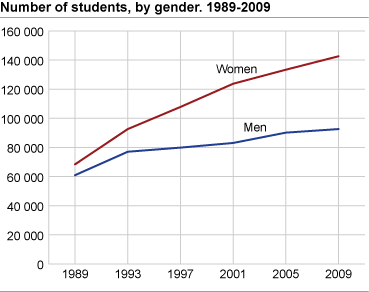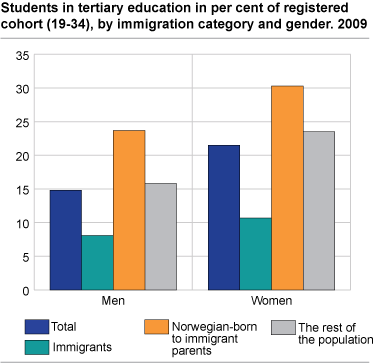Content
Published:
This is an archived release.
Changes in tertiary education participation
The tertiary education participation rate among young adults whose parents have primary or lower secondary education as their highest level of education, was 10.7 per cent within the age group 19-24 in 2009; 7.3 percentage points higher than in 1991.
The proportion of adults who participated in tertiary education increased as the level of parental education increased. The participation among 19-24 year-olds whose parents have long tertiary or short tertiary education as their highest level of education was 55 and 37.7 per cent respectively. This proportion was only 6.3 per cent for those whose parents have primary or lower secondary education and 16.8 per cent for those whose parents have upper secondary education.
In 2009, the participation rate in tertiary education of around 38 per cent within the age group 19-24 was 10 percentage points higher than in 1991. However, female students experienced the largest increase in participation rate. While participating growth for 19-24 year-olds whose parents have primary or lower secondary education was only 4.2 percentage points among men, this proportion was up by almost 11 percentage points among women. Among those whose parents have long tertiary education within the same age group, the female participation rate advanced 7.3 percentage points, while the males had a slight reduction of 0.2 percentage points.
A total of 225 400 students in Norway and Norwegian students abroad were registered in tertiary education in 2009, up 4 per cent from the previous year. Universities accounted for about 91 100 of enrolments, rising by 6 000 from 2008. Some of the increase in public university enrolments was due to the completion of the merging process between the university of Tromsø and university college of Tromsø as of 1 January 2009, and consequently the addition of the university college of Tromsø to the public university sector. The increase of about 1 100 Norwegian students studying abroad in 2009 represented about 11 per cent of the growth in total enrolment.
How students are registeredEach student is counted once even if he/she is registered in several educational activities or is registered in more than one educational institution. or more information on the control and revision process, see About the statistics . |
Largest increase among students aged 19-24
Enrolment within the age group 19-24 rose at a faster pace than the increase in total enrolment. The student population in this age group increased by 7.5 per cent from 2008 to 2009. A total of 70 540 women within this age group registered for class, up 6.7 from the previous year, while the corresponding number of men rose roughly 9 per cent. The gain in enrolment within this age group was primarily due to two factors. First, there was an increase of people aged 19 to 24 in the population. Second, the proportion of young adults in tertiary education increased.
The participation rate in tertiary education within the age group 19-34 is much lower among immigrants than the population as a whole. Male immigrants in this age group had a participation rate of almost 8 per cent, while the corresponding figure for female immigrants was about 11 per cent. In the population as a whole, the corresponding rates were about 15 and 21.5 per cent respectively. The low participation rate among immigrants is related to the fact that most of them come to Norway as labour immigrants. In addition, this group is composite with regard to the period of residence in Norway.
Most students in Health, welfare and sport
There was a growth in every field of study in 2009. Almost 52 600 students were registered in Health, welfare and sport, up approximately 2 250 from 2008. Enrolment in Natural sciences, Vocational and Technical subjects reached 37 050, up more than 1 700 from 2008. Men represented around two-thirds of the student population in this field.
In 1999, Natural sciences, Vocational and Technical subjects was the largest field of study and represented over 18 per cent of the total student registrations. In 2009 on the contrary, most students enrolled in Health, welfare and sports. Women now account for roughly 78 per cent of all students in this field. Enrolment in Teacher training and pedagogy reached 32 130, up 1 630 from 2008. This field also had the largest proportion of female students, more than 76 per cent.
Tables:
- Table 1 Students in tertiary education in Norway and Norwegian students abroad, by gender, type of college, ownership and educational institution. 1 October 1999, 2008 and 2009
- Table 2 Students in tertiary education in Norway and Norwegian students abroad, by gender, age and type of college. Absolute figures and per cent. 1 October 2009
- Table 3 Students in tertiary education in Norway and Norwegian students abroad, by gender and field of education. 1 October 1999, 2008 og 2009
- Table 4 Students in Norway and Norwegian students abroad, by county of residence at the age of 16. 1 October 1999 and 2009. Percentage women
- Table 5 Norwegian students in tertiary education abroad, by gender and countries of destination. 1 October 1999, 2008 and 2009
- Table 6 Students in tertiary education in per cent of registered cohort, by immigration category, selected age groups and region. 1 October 2009
- Table 7 Students in tertiary education in per cent of registered cohort, by immigration category, gender and age. 1 October 2009
- Table 8 New students, by gender and age. 1999, 2008 and 2009
- Table 9 Students in tertiary education in per cent of registered cohort, by age group, gender and parents' educational attainment level. 1991, 2008 and 2009
Contact
-
Geir Nygård
E-mail: geir.nygard@ssb.no
tel.: (+47) 48 15 13 44
-
Maj-Lisa Lervåg
E-mail: maj-lisa.lervag@ssb.no
tel.: (+47) 45 68 84 72


